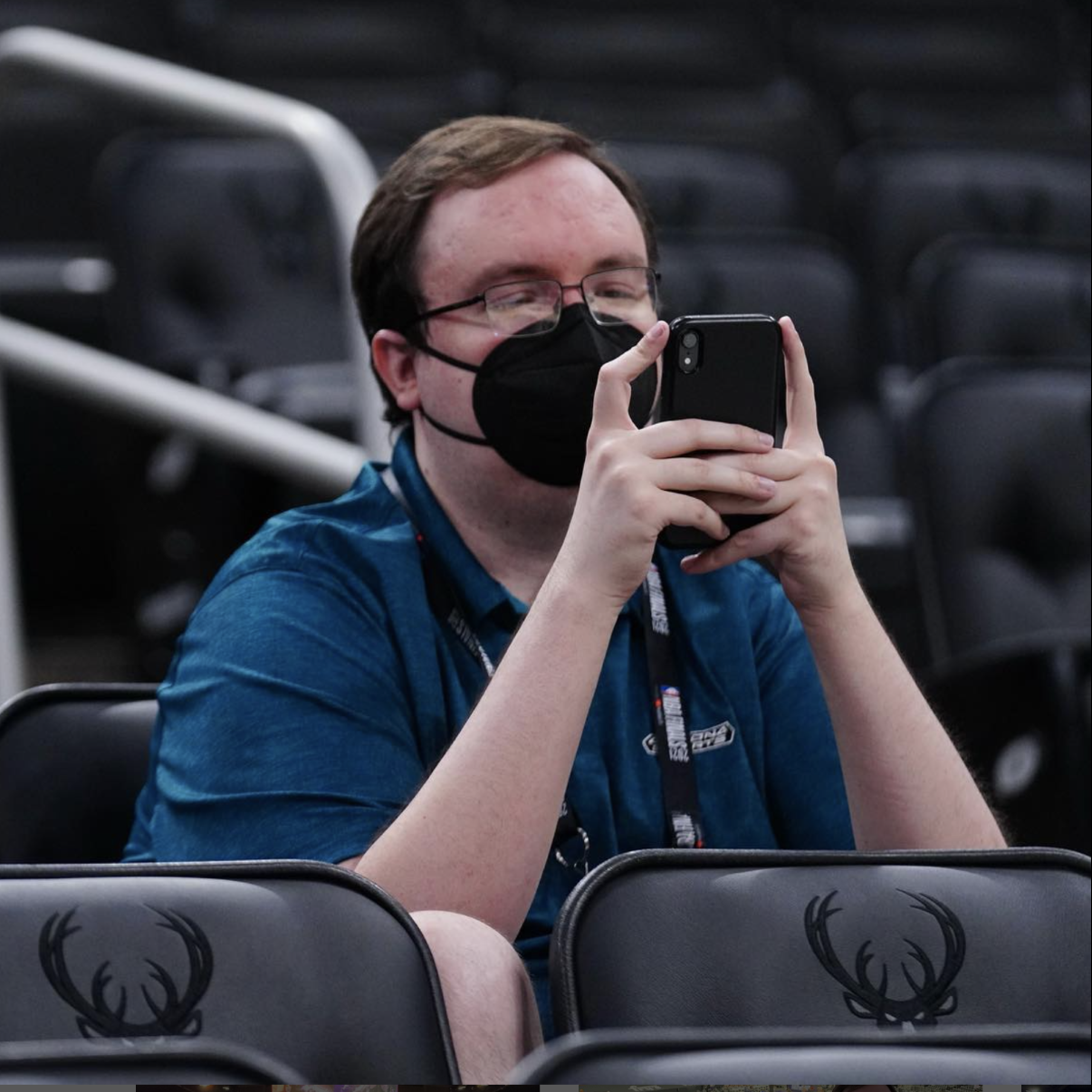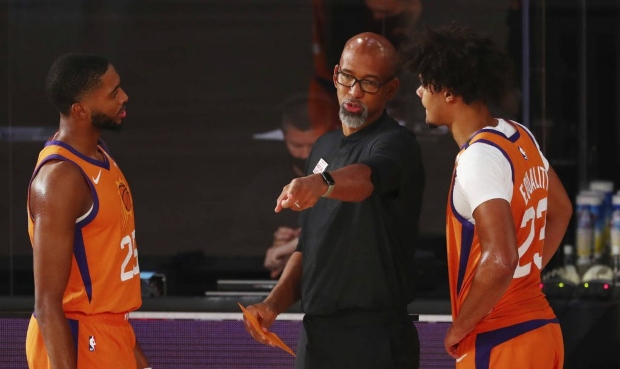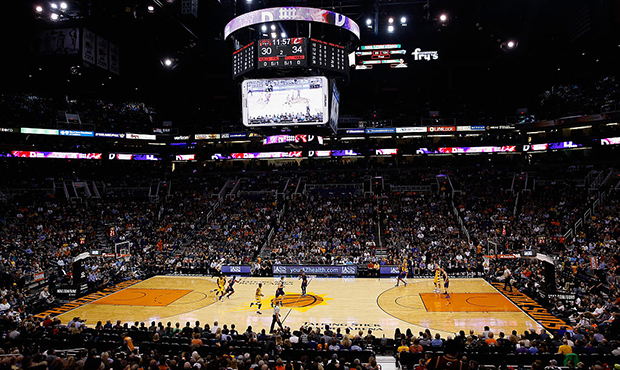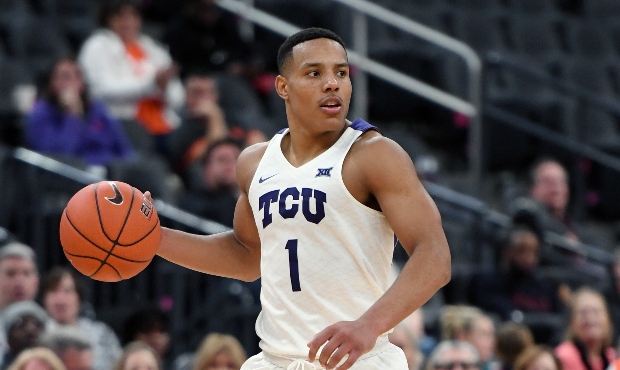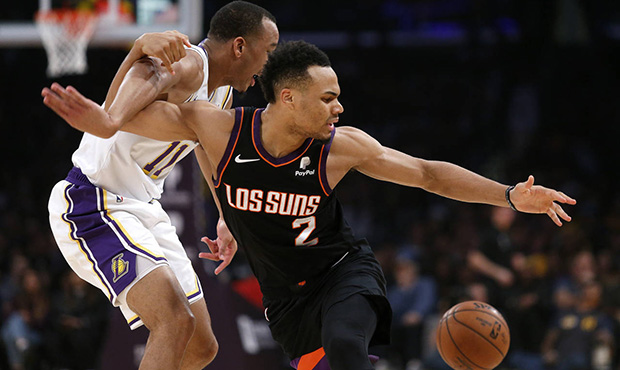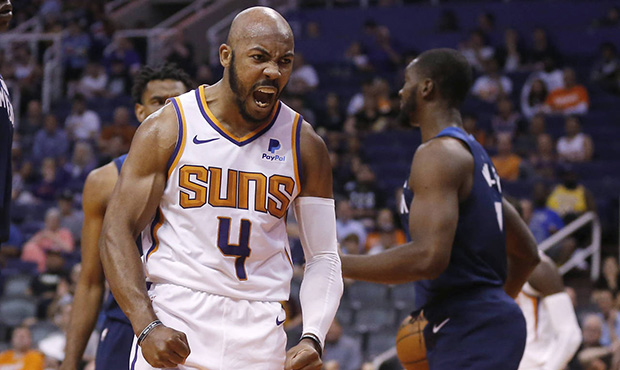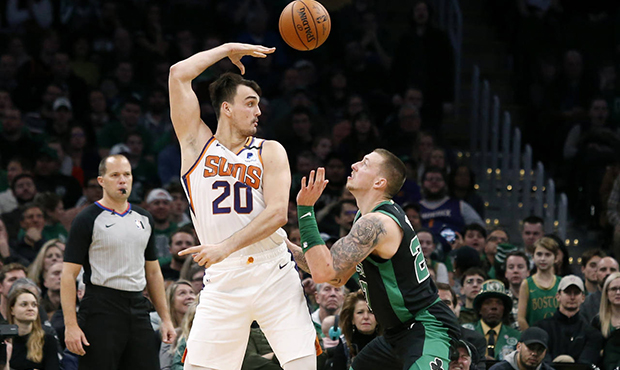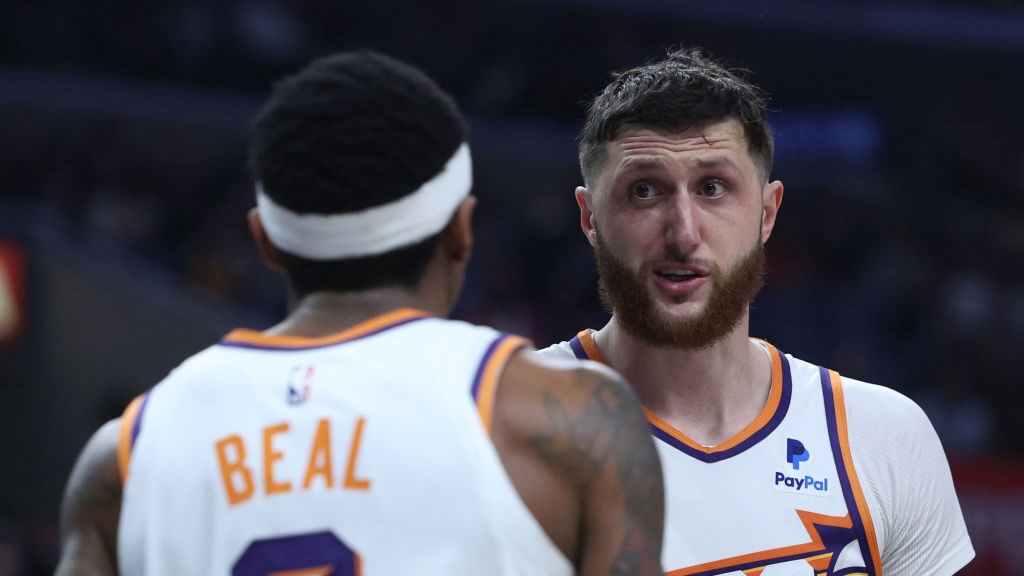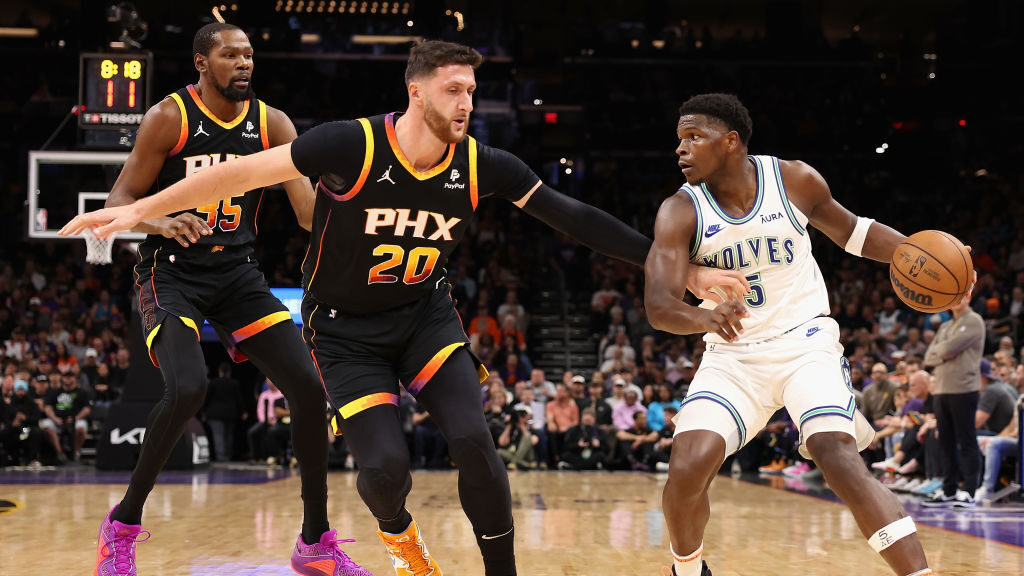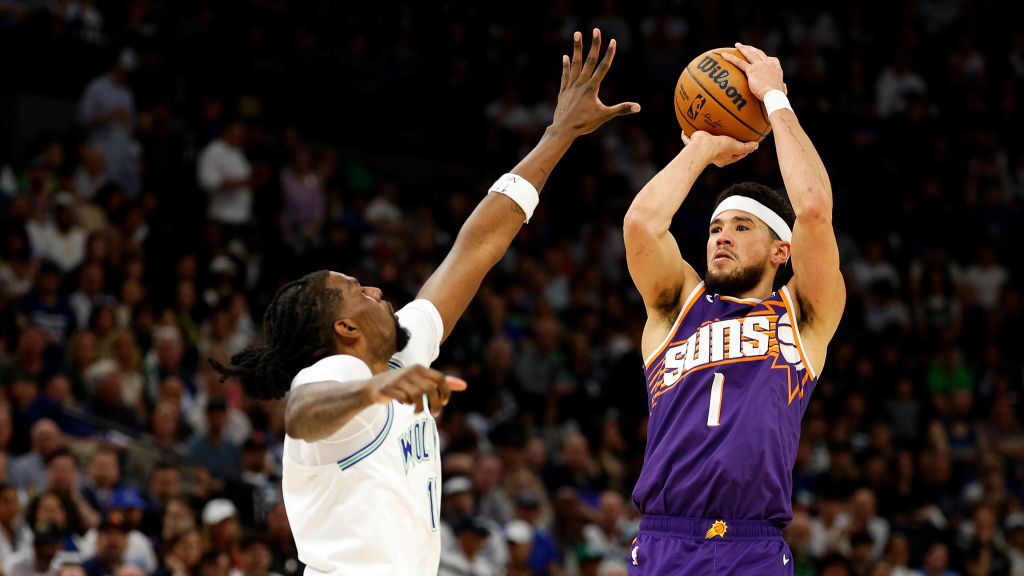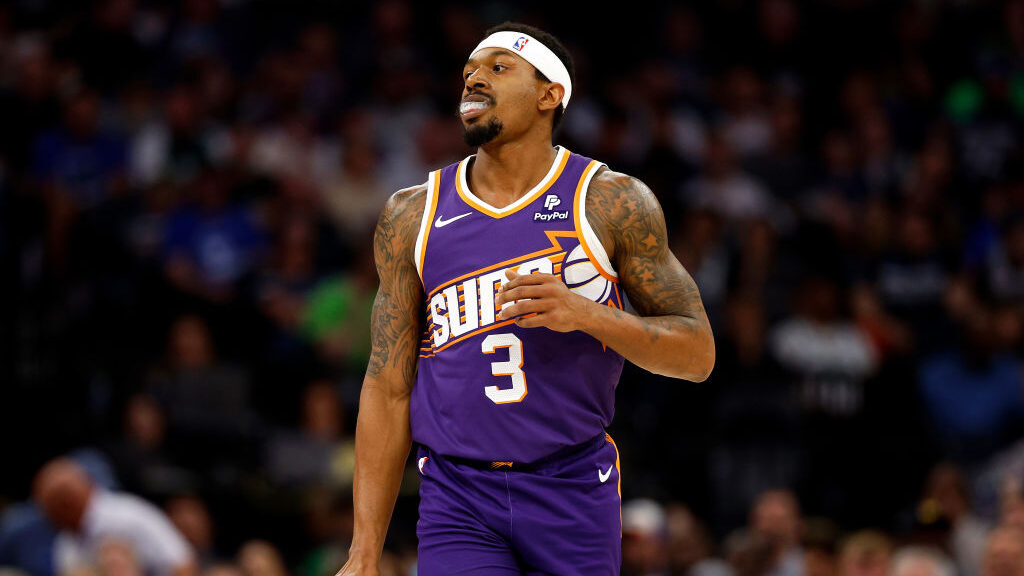Suns offseason questions: Is an effort made to create max cap space?
Oct 15, 2020, 4:03 PM | Updated: 4:35 pm

Phoenix Suns general manager James Jones speaks to the media regarding the firing of Suns head coach Igor Kokoskov, Wednesday, April 24, 2019, in Phoenix. (AP Photo/Matt York)
(AP Photo/Matt York)
The NBA Draft is a little over a month away. On top of that day being one of the top-three of the year when it comes to trade activity, first-round selections will answer some offseason questions as well.
Empire of the Suns previews what those questions are for the Phoenix Suns before that day.
Free agency is going to be weird this NBA offseason, and not just because of the economic effects of a pandemic. The Phoenix Suns have half the roster to make decisions on that will impact how much they can really do with their money moving forward.
It adds up to the most complicated offseason for the team in the last few years.
It’s a lot to lay out, so get hydrated and some food in that belly if you haven’t already. We’re going to be here a while. Don’t say I didn’t warn you.
Alrighty.
There are only six teams that project to have cap space. This is “projecting” some clear-cut moves, such as Anthony Davis’ return to the Los Angeles Lakers and Brandon Ingram re-upping with the New Orleans Pelicans, so keep in mind that this could change with some unforeseen free-agent decisions and/or trades. For now, though, it’s six teams.
The Miami Heat are one of them, and could easily choose to retain players like Jae Crowder and Goran Dragic instead of creating that room. In New York, the Knicks have $41 million in non-guaranteed contracts to decide on that will predicate which direction they go in.
The Suns are in this group. Cap numbers are tricky and the actual cap, while expected to remain flat, hasn’t been negotiated yet with so much up in the air for 2020-21. The most likely scenario is the cap stays at $109.1 million, the same number as last season.
Based on that, Cleaning the Glass projects a maximum cap space number for Phoenix at $22.3 million when the team declines all options, renounces all holds and doesn’t factor in the Suns’ first-round pick yet (more on that later).
Some teams will still have tools like the full midlevel exception ($9.3 million) to sign players, so that doesn’t rule them out of getting respectable names.
But the other three teams who should have cap space are the Atlanta Hawks, Charlotte Hornets and Detroit Pistons. That’s noteworthy, since, well, they’re the Hawks, Hornets and Pistons.
The Suns could be the best destination with over $10 million to offer if the Heat run it back and you agree with me that playing for the Knicks seems like a bad idea.
How the Suns can get there is what we will be discussing, because at this very moment they’re $7 million over the cap. The players they’ve got choices on are Aron Baynes, Dario Saric, Frank Kaminsky, Jevon Carter, Elie Okobo, Cameron Payne and Cheick Diallo.
We will knock off four names right now to make things easier.
Elie Okobo, G, 22 years old
Key stats: 4.1 points, 2.1 assists, 39 FG% in 13.1 minutes per game
Contract: 2020-21 $1.7 million (non-guaranteed), 2021-22 $1.8 million (team option)
The former second-round pick of the Suns has squandered multiple opportunities the past two years to earn legitimate playing time. When Tyler Johnson clearly wasn’t the man for the job as the first guard off the bench last season, Okobo wasn’t all that great in his place and appeared to be the young player more than anybody who frustrated head coach Monty Williams.
That could be enough to waive the non-guaranteed deal he’s on the books for, but the play of Carter and Payne in the bubble is the extra bit of guarantee. Ty Jerome and Jalen Lecque’s guaranteed contracts for next season also make it crowded at guard.
Cameron Payne, G, 26 years old
Key stats: 10.9 points, 3.0 assists, 1.0 steals, 49 FG% in 22.9 minutes per game
Contract: 2020-21 $2.0 million (team option)
Let’s safely assume Payne is brought back on his option.
While the Suns should be aggressive in seeking a top guard for the second unit, Payne was one of the biggest reasons why Phoenix went 8-0. He bought into the style of play, has a connection with Williams and clicked with the guys during a huge moment in this young core’s growth.
Payne is perfect for the end of the bench, someone Williams can reliably call on if injuries occur.
Cheick Diallo, C, 24 years old
Key stats: 4.7 points, 2.8 rebounds, 65 FG% in 10.2 minutes per game
Contract: 2020-21 $1.8 million (team option)
There was a moment just after Deandre Ayton’s 25-game suspension when Williams called upon Diallo in the second game of the season, saw him out there for two minutes and then didn’t put him back in the rotation until Baynes got hurt two weeks later.
His lack of court sense was apparent all year despite his ability to produce.
The only reasons Diallo’s return would make sense are that it’s a small deal and he knows the system already, but again, Phoenix can presumably find someone better suited for them.
Jevon Carter, G, 25 years old
Key stats: 4.9 points, 1.4 assists, 43 3P% in 16.3 minutes per game
Contract: Restricted free agent ($1.8 million cap hold)
One more quick tag we’ll make before clicking pause is the Suns tendering Carter a qualifying offer to make him a restricted free agent. He was a legitimate part of the team throughout the season and showed a much better understanding in the bubble for how to play his role offensively.
Carter shot it great from deep and became a solid “0.5” player by the end of the season, all while being his usual bulldog self defensively. As long as those two things are sustainable next year, he deserves to be back in the rotation as the off-ball guard.
OK. Let’s refresh with where we’re at in waiving Okobo, accepting Payne’s player option, declining Diallo’s and tendering Carter.
With the obvious moves done, the Suns are still over the cap, and that’s because of cap holds Baynes and Saric take on at $10.4 million each, and the $5 million team option for Kaminsky.
Let’s run through those three players before we get to leaning in one direction or the other on what to do with them, because they all factor in together.
Frank Kaminsky, PF/C, 27 years old
Key stats: 9.7 points, 4.5 rebounds, 1.9 assists, 33 3P% in 19.9 minutes per game
Contract: 2020-21 $5 million (team option)
I can hear you yelling at me through your screens that the Suns should be declining Kaminsky. He didn’t play well most of the time he was out there, but most of the time he was out there was in a role Phoenix didn’t sign him for.
Kaminsky was brought in to be the fourth big behind Ayton, Saric and Baynes. But with Ayton’s suspension and injuries for all three outside of Saric, the trio of Ayton, Baynes and Kaminsky played only two games together.
That’s right, two: The opener before Ayton got suspended and a Dec. 28 win over the Sacramento Kings, the same game Kaminsky got hurt in. He went on to miss the two-plus month stretch where Ayton and Baynes spent the most time playing with one another.
Kaminsky shouldn’t be judged on starting at center or serving as the primary backup at that spot, but that’s where he was nearly all season. He’s a well-liked teammate, a smart passer and a great shooter for his size. While I’ll admit his play was ugly at times, don’t completely rule out his return.
Dario Saric, PF/C, 26 years old
Key stats: 10.7 points, 6.2 rebounds, 1.9 assists, 36 3P% in 24.7 minutes per game
Contract: Restricted free agent ($10.4 million cap hold)
Saric was a different player in the bubble, going from unreliable as a rotation player to one of the team’s five best players over that eight-game stretch.
Playing with a new sense of aggression, Saric’s potential as a small-ball five finally shined through.
If the Suns buy what they saw in Orlando, it’s a no-brainer to at least get him on a qualifying offer and see what comes of his RFA market.
Aron Baynes, C, 33 years old
Key stats: 11.5 points, 5.6 rebounds, 1.6 assists, 35 3P% in 22.2 minutes per game
Contract: Unrestricted free agent ($10.4 million cap hold)
Baynes’ season shifted dramatically in his second half. After returning from his first injury, he appeared fresh for a few weeks before wearing down again and wasn’t the same the rest of the way.
— Baynes’ first 23 games: 13.0 PPG, 5.5 RPG, 2.2 APG 52.7/37.0/72.7
— Baynes’ last 19 games: 9.5 PPG, 5.8 RPG, 0.9 APG 41.5/32.9/77.4
That was surely skewed by Baynes playing serious minutes for the first time in his career, something his body eventually wasn’t able to handle.
He has obvious value as a veteran and reliable bench presence, but will surely have a lot of suitors, and the Suns may have to pay quite a bit for him. They’d have a reason to hesitate on anything longer than a one-year deal based on what they saw last season.
To keep this concise enough and, quite frankly, in a space where we can keep the discussion somewhat centralized, there are basically three potential paths the Suns can go down from this position. It’s still rather dizzying, so really lock in with me here.
Option 1 – Get the big name
Phoenix can gut all their money left over to open as much room as possible. They can decline Kaminsky’s option, and renounce both Saric’s and Baynes’ cap holds and Bird rights (more in a bit on what that means).
With the 10th overall pick having a hold of $4.2 million, that would leave them something around $16 million to work with.
This is essentially the “go big or go home” edition, with ambitions of signing one of the higher-rated free agents. They could also go over the cap if they so choose by using the room midlevel exception — $5 million, the exception Kaminsky was signed on last summer — to add an extra piece toward the end of the rotation, plus whatever Carter’s deal winds up being.
If they whiff on the big name, they’d still have chunks of cap space they can divvy among 2-4 guys, depending on how weird they want to get with it.
In my opinion, the Suns are only going to do this if 1) they are over the trio of bigs and don’t want them anyway or 2) they are really honed in on a free agent like Davis Bertans, Danilo Gallinari, Jerami Grant, Serge Ibaka, Paul Millsap, etc.
Again, it would not be a grand delusion for the Suns to think they have a chance at a big splash for one of those guys because of the limited market and the competition.
This is a little closer to foolish rationale, but maybe they believe they are a substantial signing away from being a near-lock to make the postseason. Maybe even to the point where they deny the notion this draft class could give them a win-now piece, and they trade the first-round pick to create more spending room. Who knows.
If they want Baynes or Saric back, however, it’s the next one.
Option 2 – Keep a big
Option two is somewhat of a middle ground. They keep one of Baynes’ or Saric’s holds while letting go of Kaminsky. After the No. 10 pick’s hold, that leaves roughly $7 million in cap space.
The Suns could bring in two decent-ish rotation players that the majority of the teams over the cap don’t want to spend their full midlevel exception ($9.3 million) on by signing one player with almost the entirety of their cap space and another on the room midlevel exception ($5 million) to go over the cap on.
They can then go over the cap even more by either re-signing Saric or Baynes, and they can do that on Saric and Baynes because they own their Bird rights.
Saric is restricted if they tender him a qualifying offer, and they can match any offer he accepts if that’s the case. While the Suns don’t have that choice on the unrestricted Baynes, they can still go over the cap to sign him because they possess his Bird rights. The Suns can choose to pull Saric’s qualifying offer as well and make him unrestricted, so tendering him isn’t much of a big deal.
Putting on the roster construction hat for a moment, this second route would effectively be spending that $7 million on a third guard and the room midlevel on a big with the return of Baynes or Saric. Now it’s:
Rubio – FA guard – Payne – Jerome – Lecque
Booker – Carter – No. 10 overall
Bridges – Johnson
Oubre – room midlevel
Ayton – Baynes/Saric
That looks about right, eh? That’s my best guess of the path they take.
Here’s the last one, the “full send.”
Option 3 – Spend! Spend! Spend!
The Suns can remain stopped where I have us now as a team over the cap and still have the ability to re-sign Saric and Baynes via their Bird rights and can also accept Kaminsky’s team option if they’re feeling that crazy. As that team over the cap, they also now get that full midlevel exception of $9.3 million instead of the room at $5 million, so that’s a decent piece to add there too if they so choose.
This, of course, would require an ownership group really willing to spend money, and judging by the sale of the G League team and expensive renovations being completed, let’s be kind by just calling this as an unlikely outcome and move on.
If you want a more extended overseeing eye on the potential routes and extra parameters I didn’t have time for, I couldn’t recommend David Nash’s newsletter post on this enough, the residential cap expert on Suns Twitter. He’ll answer all your questions on Twitter too, I promise. Tell him I sent you.
So there it is. There are a lot of different ways for the Suns to go, and it could get even funkier if they decide to trade Kelly Oubre Jr. to open up more cap space.
It doesn’t feel like it, but it’s certainly a critical offseason in regards to these possibilities.

